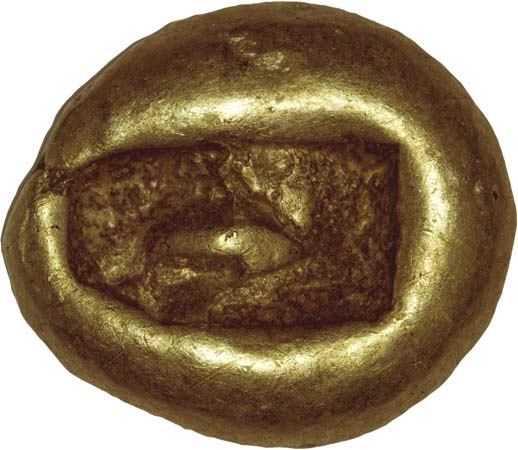Lydian Striated Stater
The Lydian striated Stater is the first attempt in western civilization at assigning value to small pieces of metal in order to facilitate trade. These small electrum (a mixture of gold and silver) coins are the first “coins” made around 660 BC. Within 60 years, many Greek city-states began to copy the idea. The Lydian Empire, existed from about 1200 BC to 546 BC.

Government-Sanctioned Currency
Bronze shapes and precious metals were used in commerce prior to the introduction of the stater. However, the gold/silver bars and rings that were used came in many sizes and, therefore, had to weighed during each transaction in order to assess their value. In comparison, staters had a relatively accurate weight of 220 grains of wheat. They were also produced in fractional coins, including third-staters, sixth-staters, twelfth-staters, as well as fractions of 1/24, 1/48, and 1/96.
The first Lydian staters were blank, with striations on one side of the flan. Later, an anvil die was used to stamp the coins with a lion’s head, the symbol of Lydia’s Mermnadae dynasty. The use of the “Lydian Lion” symbol demonstrated that the coins were official tender of the kingdom. Other kingdoms subsequently followed suit, striking coins with their own hallmark images. However, Lydia was the first to add a seal that linked the coin to a ruling authority, thereby adding legitimacy to the currency’s use in trade.
The coins were comprised of electrum, a natural occurring alloy of gold and silver. Lydia’s Pactolus River was one of the greatest sources of the metal found in the ancient world. As described by ancient Greek historian Herodotus, “Lydia does not have many marvelous things to write about in comparison with other countries, except for the gold dust that is carried down from Mount Tmolus.”
Kingdom of Lydia
The coins were minted in Lydia’s capital city of Sardis, which was located in the western region of Asia Minor in the Hermus and Cayster Valleys. Lydia’s location between the Asian kingdoms of the east with the coastal Greek cities of Ionia made it a prosperous trading center, with merchants holding high-esteem in the kingdom. As described by Ernst R. Curtius: “The Lydians became on land what the Phoenicians were by sea, the mediators between Hellas [Greece] and Asia.”
The first Lydian coins were minted under Alyattes I, who reigned from 591 BC to 560 BC. His son, Croesus, went on to further refine the minting process by issuing the Croeseid, the first standardized gold coin. While Lydia was ultimately conquered by the Persians, the kingdom’s contributions to the ancient world lived on through its staters
